Ever notice that stuffy feeling after a long day inside? That’s your indoor air sending a warning. The good news? You don’t need a scientist’s lab to fix it. A few quick habits and low‑cost gadgets can make the air in your home or office feel like a fresh mountain breeze. Let’s break down what you can do right now without breaking the bank.
Open a window for a few minutes each morning. Even a short burst of fresh air pushes out stale pollutants and lowers humidity, which stops mold from growing. If you live in a noisy street, try a window fan that pulls fresh air in while pushing old air out. Next, check your HVAC filter. A filter rated MERV 8 or higher traps dust, pollen, and tiny particles. Swap it out every three months – it’s a tiny chore that makes a big difference.
Cooking, cleaning, and even your pets release invisible particles. Use a range hood while you fry or bake; if you don’t have one, a simple portable air purifier with a HEPA filter can catch most of the smoke and odor. Choose cleaning products that are fragrance‑free and plant‑based; they leave fewer chemicals behind. Finally, place houseplants like spider plant or peace lily near problem spots – they absorb some VOCs and add a touch of green.
Don’t forget to keep humidity in check. A humidifier can be great in winter, but too much moisture invites mold. Aim for 30‑50% relative humidity; a cheap hygrometer tells you the exact level. If you see condensation on windows, that’s a sign you need to run a dehumidifier or open a window briefly.
One more easy win: change your mattress and pillow covers to allergen‑proof versions. Dust mites love a warm, soft surface, and a zip‑up cover blocks them. Wash the covers in hot water once a month and you’ll notice fewer sneezes and less itchy skin.
All these steps add up to a healthier breathing environment without a massive overhaul. Pick a couple that fit your lifestyle, try them for a week, and notice the difference. Cleaner air means better sleep, clearer thoughts, and fewer headaches – all with minimal effort.

Learn practical ways to protect your throat lining from dry air, smoke, allergens and other irritants. Includes hydration tips, humidifier use, mask advice, and a comparison of protective methods.